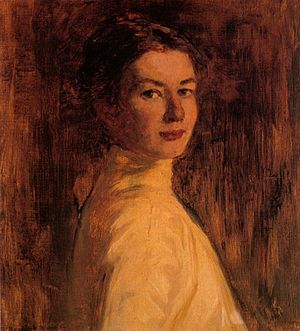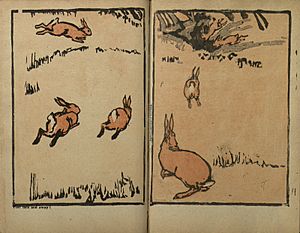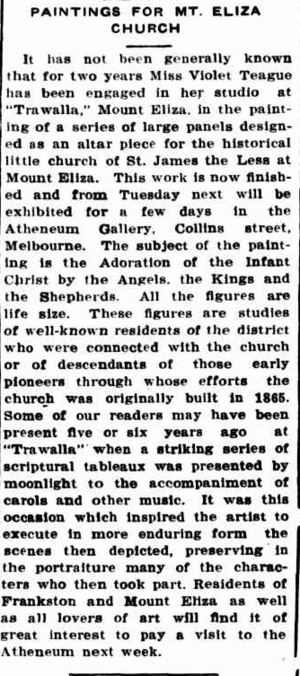Violet Teague facts for kids
Quick facts for kids
Violet Teague
|
|
|---|---|

Self portrait (1899)
|
|
| Born | 21 February 1872 |
| Died | 30 September 1951 (aged 79) Mount Eliza, Victoria
|
| Education | National Gallery of Victoria Art School, Melbourne |
| Known for | Etching, lithography |
|
Notable work
|
|
| Awards | Bendigo Jubilee Exhibition gold medal, 1901 |
Violet Helen Evangeline Teague (born February 21, 1872 – died September 30, 1951) was an important Australian artist. She was well-known for her beautiful paintings and her unique printmaking skills.
Contents
Violet Teague's Early Life and Education
Violet Teague was born in Melbourne, Australia, on February 21, 1872. She was the only daughter of James Teague, a doctor, and his wife Eliza Jane Miller. Sadly, her mother passed away when Violet was very young. Her father and his second wife, Sybella, raised her.
Violet was taught at home by a governess. She learned many subjects, including French and classics (ancient Greek and Roman studies). She later finished her college education at the Presbyterian Ladies' College, Melbourne.
Traveling and Art Studies Abroad
When Violet was a young woman, she traveled across Europe with her family. She visited many art galleries in countries like Germany, France, Belgium, the Netherlands, and England. She remembered seeing amazing paintings in Spain, especially the works of Diego Velázquez and Raphael.
Violet also studied art in Europe. She learned from famous artists like Ernest Blanc-Garin in Brussels and Sir Hubert von Herkomer in England. These experiences helped her develop her own artistic style.
Violet Teague's Art Career
Violet Teague showed her artwork in famous art shows called the Paris Salons. In 1897, she displayed a portrait of a Colonel Rede at the Société des Artistes Français.
In 1902, she became a member of the council for the Victorian Artists Society. This group even published a poem she wrote called 'A Cloud Fantasy' in their magazine.
Pioneering Japanese Woodblock Printing in Australia
Violet Teague was the first Australian artist to really understand and use Japanese woodblock printing. This type of printing has a long history in Japan.
In 1905, she worked with her friend Geraldine Rede to create a special book called Night Fall in the Ti-Tree. They made the book in Violet's studio in Collins Street. This small book had 32 pages of Haiku-style poems about the simple life of bushland rabbits. It also featured 16 colorful woodblock pictures.
This book was very important because it was:
- The first example of colored woodblock printing in Australia.
- The first "artists' book" made in Australia.
Award-Winning Paintings and Recognition
Violet Teague's painting called Boy with a Palette won a silver prize in Paris in 1920. It was later shown at the famous Royal Academy of Arts in London.
Another Australian artist, Rupert Bunny, wrote to Violet after seeing her painting. He said that The Boy with the Palette was one of the best artworks at the Paris exhibition that year.
Creating Art for Churches
One very unique part of Violet Teague's art was her creation of altar paintings and banners for Protestant churches. This was quite rare for an Australian artist.
- In 1910, she painted an altar piece for a church in Wannon, Victoria. This painting is now in the Hamilton art gallery. Her friend, artist Jessie Traill, designed the frame for this artwork.
- In 1921, Violet showed another altar piece for a new church in Kinglake, Victoria. This church was built to remember soldiers who died in World War I. Jessie Traill also helped with this piece by preparing special words to go with the painting. This painting is now at St. Paul's Cathedral in Melbourne.
Journey to Hermannsburg Mission
In 1933, Violet Teague and her sister Una traveled by car across the Australian outback. They visited the Hermannsburg Mission, which was facing a severe drought. Many Aboriginal people had died because of the lack of water.
The sisters helped raise over £2,000 to build a pipeline. This pipeline would bring water to the Mission and help the community. During her visit, Violet also met the famous Aboriginal artist Albert Namatjira. He even named one of his children after her!
Violet Teague's Legacy
Violet Teague is remembered as one of Australia's best portrait painters. She was also one of Australia's first female art critics, meaning she wrote about and reviewed art.
A street in the Canberra suburb of Cook is named Teague Street in her honor.
Images for kids








